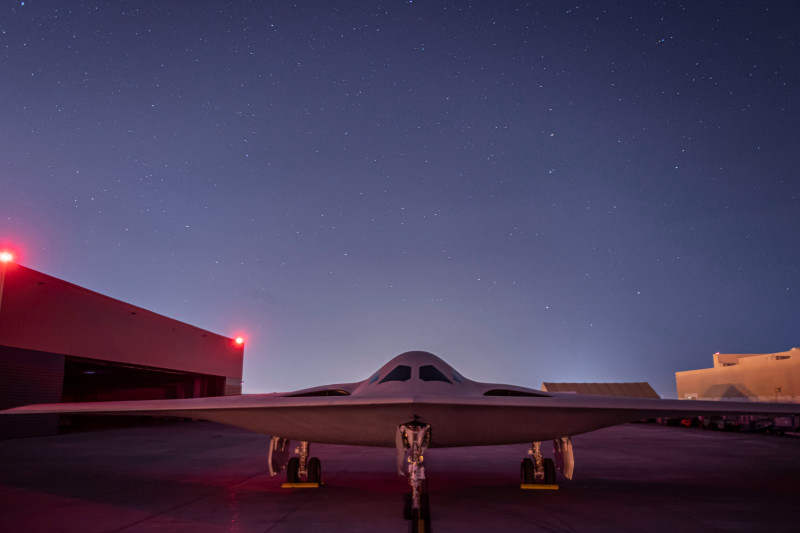The B-21 Raider is stealth technology and is intended to replace the B-1 Lancer and B-2 Spirit – It is a long-range aircraft, capable of carrying conventional and nuclear weapons – The first 6 test aircraft are in the process of production
At the same time that Russia is waging war in Ukraine, the US is making a show of strength in new-age weapons, unveiling the new B-21 Raider stealth bomber.
The B-21 is not expected to be operational and operational any time soon, but the official unveiling ceremony organized by Northrop Grumman Corporation at its production facilities in California is an important milestone in the US Air Force’s effort to modernize its combat capabilities. The B-21 is designed to be a more capable and adaptable, state-of-the-art aircraft that will gradually replace the aging B-1 Lancer and B-2 Spirit bombers now in service.
According to design requirements, the B-21 is a long-range, highly survivable stealth bomber capable of carrying a mix of conventional and nuclear munitions. The aircraft will play an important role in supporting national security objectives and safeguarding US allies and partners around the world.
Senior defense officials note that the National Defense Strategy and other analyzes make clear the need for the B-21 and its capabilities.
“The B-21 Raider is the first strategic bomber in more than three decades,” Defense Secretary Lloyd J. Austin said during the ceremony. “It’s a testament to America’s enduring strengths in ingenuity and innovation. And it’s a testament to the Department’s long-term commitment to building advanced capabilities that will strengthen America’s ability to deter aggression, today and in the future.”
The B-21, Austin said, “is a deterrent in the American way. This is not just another plane. It’s not just another acquisition. He is the embodiment of America’s determination to defend the democracy we all love. It’s a testament to our strategic deterrence – with the capabilities to back it up, every time, everywhere.”
The world and its threats have changed dramatically since the last new bomber was introduced in 1988, as has the way the Air Force, other US military services and allies work together as a joint multi-domain force. Senior defense officials say new thinking and innovation are needed to deal with new and emerging threats.
“You think about what we can do over time with the workforce here from Northrop Grumman, working with the United States Air Force to get a capability using a digital approach that’s new and different than anything else. Any major program I’ve done, that’s part of the Raider spirit,” he said.
The B-21 is the first new bomber introduced since the end of the Cold War. Air Force officials envision an ultimate fleet of at least 100 aircraft with an average unit procurement cost requirement of $692 million (base year 2022 dollars).
“When I think about accelerating change, that’s exactly what it means to be able to bring that kind of capability very quickly and to be able to adapt it to the threat,” Brown said in his meeting with reporters. “And today, I’m really excited that we’re bringing the B-21 Raider into the future. It will be the backbone of our bomber fleet.”
The aircraft is designed with updated stealth qualities and mission flexibility that senior leaders in the Air Force and across the Defense Department say are essential to achieving the U.S. goal of achieving comprehensive deterrence and, if necessary, the capabilities needed to the successful response to aggression anywhere in the world at any time.
The particular B-21 unveiled on December 2 is one of six in production. Each is considered a test aircraft, but each is built on the same production line, using the same tools, processes and technicians that will build production aircraft. This approach enabled engineers and production technicians to capture lessons learned and apply them directly to subsequent aircraft, emphasizing repeatability, productivity and quality.
Time to first flight will be data and event, not date based.
While the exact date the B-21 will enter service is unknown, key decisions have been made. Ellsworth AFB, South Dakota will become the first primary operating base and official training facility for the B-21. Whiteman AFB, Missouri, and Dyess AFB, Texas, are the preferred locations for the remaining home bases. Each will receive aircraft as they become available.
In addition to building a bomber with state-of-the-art technology and capabilities, Air Force officials emphasized a focus on containing costs while allowing for maximum flexibility.
For example, the B-21 is designed with an open systems architecture that will enable rapid future integration of capabilities to keep pace with the highly contested threat environment.
The design of the B-21 is based on stable requirements with existing and mature technology to control program costs. In fact, the plane’s prime contractor, Northrop Grumman, has been instructed to use production processes, production tools and a production workforce that ensure continuous and uninterrupted production, avoiding unnecessary costs.
“Leveraging innovative manufacturing techniques, open systems architectures and proactive management allows us to incorporate new technology as it matures and ensures the B-21 can adapt to future threats and be successful when and where we need it,” said Assistant Secretary of the Air Force for Acquisition, Technology and Logistics, said Andrew P. Hunter.
Read the News today and get the latest news.
Follow Skai.gr on Google News and be the first to know all the news.
With a wealth of experience honed over 4+ years in journalism, I bring a seasoned voice to the world of news. Currently, I work as a freelance writer and editor, always seeking new opportunities to tell compelling stories in the field of world news.











